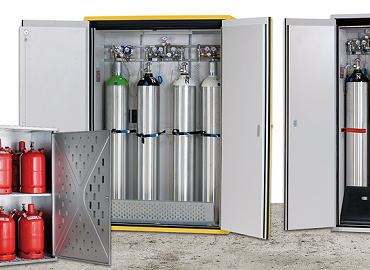A standard gas bottle is comprised of a gas being compressed into cylinders and bottles. These cylinders have a great amount of internal pressure built-up due to the compressed molecules of gas’s continuous movement. Gas compressed in cylinders can have a force of 2500 pounds per second. Hence, dropping a gas container can lead to a big blast that can destroy structures and cause devastating harm to people and the environment. Gas must be stored safely in units that can minimize the consequences if things go wrong.
To store or transport gas safely you must first identify what type of gas you are dealing with. There are many different types of gas including combustible, toxic, corrosive and oxidizing gases. Once you have identified the type of gas you can then determine the best way to store or transport it. Keep in mind that each state and territory has its own regulations set out by the relevant work safety body and you should ensure that you are following all the rules set out in the relevant regulations.
Storing Small Quantities of Gas
Upright
All gas bottles should be stored upright and secured. Preferably they would be secured in a storage cage or cabinet, but chains and straps can also be used to prevent bottles from falling. The only time a gas bottle should be horizontal is if it was made to be operated that way such as a forklift bottle. If stored horizontally, ensure that the pressure-relief valve is in contact with the vapour inside the cylinder (keep it at the top side of the bottle).
Combustible Material
The immediate area around all types of gas should be free from any combustible material. This includes fuel, paper, dried leaves and grass to name a few. In an emergency, combustible material can help spread fire faster or even start a fire on a hot day. There should be at least 3 meters clearance from all gas bottles.
Ignition Sources
Along with combustible material is also ignition sources such as grinders, welders and other forms of spark, flame or heat. This is especially important for flammable or combustible gases.
Other Types of Gas
When storing more than 1 type of gas on location, it is best to keep them as far apart as practicable, with a minimum distance of 3 meters. For example, oxidising gas (such as oxygen) should be stored at least 3 meters away from fuel gas (such as acetylene). The only time where it is acceptable to store different types of gases together is when they are connected and being used for their purpose (eg. as part of an oxy cutting set).
Ventilation
Ensure there is adequate ventilation. This is especially important for flammable gasses. Flammable gasses need ventilation to not cause an explosive atmosphere that may happen in enclosed spaces such as garden sheds.
Cover
If possible, keep gas bottles under cover away from direct sunlight and rain. This will lower the risk of damage to the bottle and potential for spontaneous combustion.
MSDS
Material Safety Data Sheet’s should be kept for all types of gases kept on premises. In the event of an emergency, the emergency services can use this MSDS to identify the hazard and remove as much risk as possible.
Placarding
Have the relevant placarding in relation to the gas you store. This will also help emergency services if they are required to attend to an emergency.
Full vs Empty
If possible, store full bottles separate from the empty bottles. Although empty bottles still need to be treated as full, by storing them separately you are removing the manual handling and excess handling of bottles to find one with gas still in it. The less you can handle the bottles, the less likely you are to have an accident.
Transport Gas
When transporting gas, you should adhere to the rules set out in the Australian Code for the Transport of Dangerous Goods by Road & Rail, Edition 7.5, 2017. This code gives a comprehensive list of rules set out for the transportation of gas around Australia.
Some general rules to follow are:
- Avoid travelling with gas in the cabin of the car or van. In case of an explosion, you are a lot safer with the bottle in a tray on a ute or truck.
- Secure the bottle upright to the headboard or something else solid, preferably using a dedicated gas bottle holder.
- Display dangerous goods signage in accordance with the ADG code.
- Before transporting, double check to make sure all bottles are not leaking or may not start to leak during transit.
If you have excess gas on your premises or you are concerned that you are not following the regulations, then give B & E Gas Supplies a call. We can provide an onsite audit and provide training to you and your staff to ensure that the risk of gas handling and storage is minimised.

